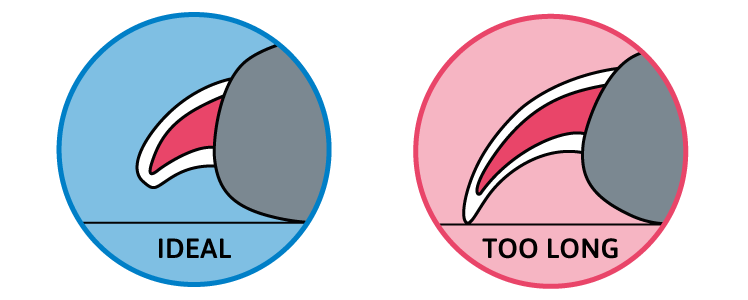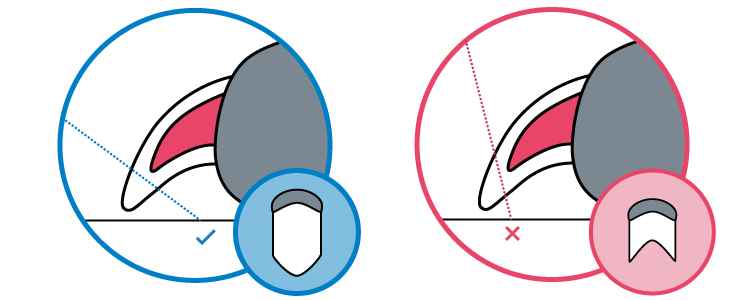 Approved by Dr. Dwight Alleyne, DVM
Approved by Dr. Dwight Alleyne, DVM How To Trim Dog Nails (Without A Trip To The Groomers)
Dogs require special treatments as much as we do. But what if one of those treatments considered as “special” turns out to be a necessary hygiene practice? Dog nail trimming, as fancy as it may sound, is not just a beauty treatment, but an action you should perform regularly.
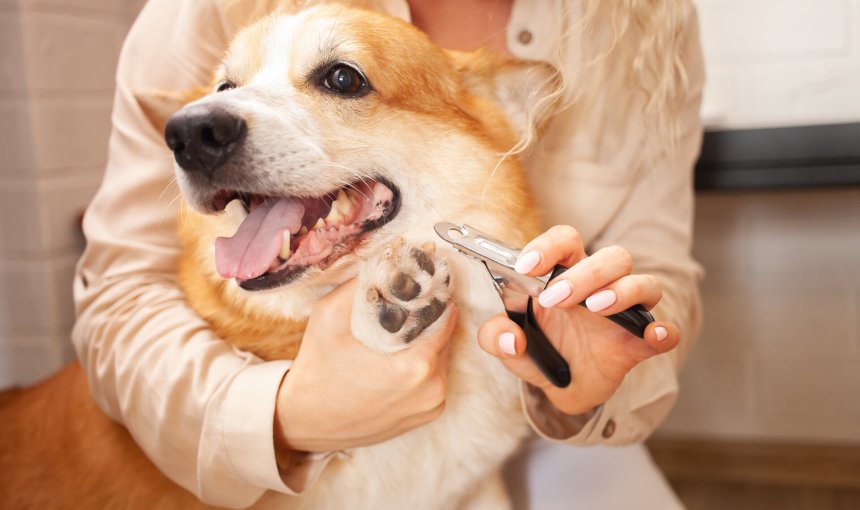
You might keep your nails styled for the cosmetic appeal – but for your dog, it’s a non-negotiable. Because as it turns out, overgrown dog nails can lead to massive pain and affect their lives negatively. But you wouldn’t be the first to wonder: how to trim dog nails? And how do I do it without expensive grooming treatments?
Taking care of your dog’s paws is an essential part of their health. So here’s a guide to trimming your dog’s nails safely at home by yourself, quickly and easily. Let’s get started!
Why is it important to trim dog nails?
When dog nails get too long, it can lead to pain and other serious issues. With time, it can significantly decrease the quality of your dog’s daily life.
- Over time, your dog might develop spine and posture problems (like sitting or standing oddly) due to frequently shifting weight because of overgrown nails.
- Too-long nails can even lead to difficulty walking, lameness or serious injury; especially if they’re so long that they touch the ground.
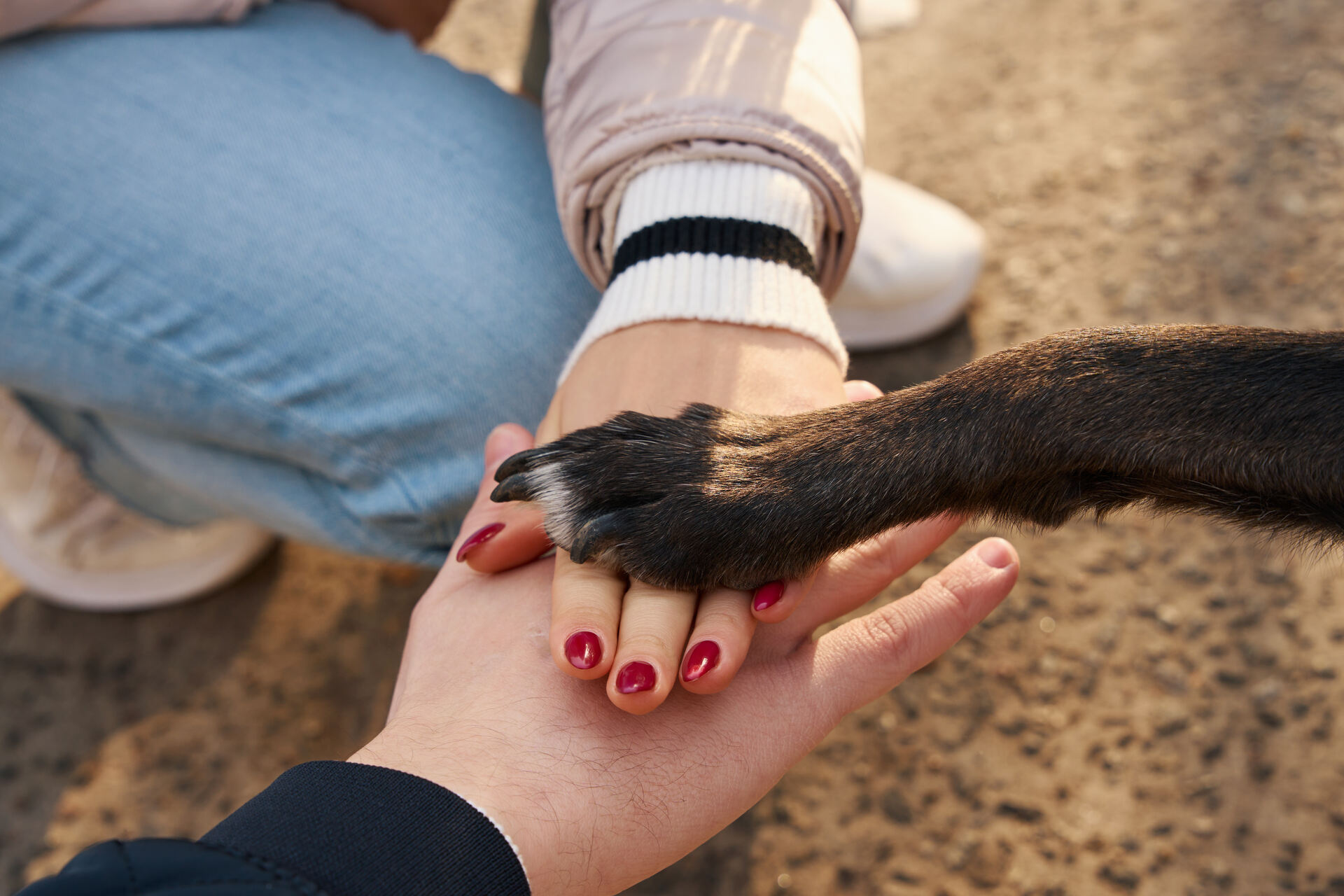
- Torn nails can snag on surfaces like carpets indoors and rocks or fences outdoors. If your dog is in the habit of roughhousing you or other pets, a particularly vigorous play session might end up with a painful ripped off nail!
- Ingrown nails can end up growing into your dog’s paw pads, causing them discomfort, pain, and opening them up to the risk of infection if this results in a wound.
And as your dog grows older, overgrown nails can limit their movements and make it more difficult to get around. Even more so if they develop mobility-affecting conditions like arthritis.

“Dogs use their nails for traction and balance when walking or running.
Nails that are too long can cause a dog to slip and fall more easily.”
– Moncton Animal Hospital1
How to know when it’s time to trim dog nails
With your furry friend standing in front of you with their front legs under their shoulders, check their nails.
- Are they touching the ground? If so, then they’re too long.
- And if you hear your dog’s nails clicking or see them turn sideways, it’s time for a trim.
Ideally, you should be able to slip a piece of paper between your dog’s nails and the floor.
How to trim dog nails at home
Step 1: Prepare the equipment
- Dog nail clippers/scissors/grinder
- Flashlight (for dark nails)
- Optional: Paw balsam
When everything is ready, get your dog comfortable and you’re good to go. If your dog is a bit nervous, calm them with biscuits or extra cuddles. This will give them a sense of security while you begin cutting.
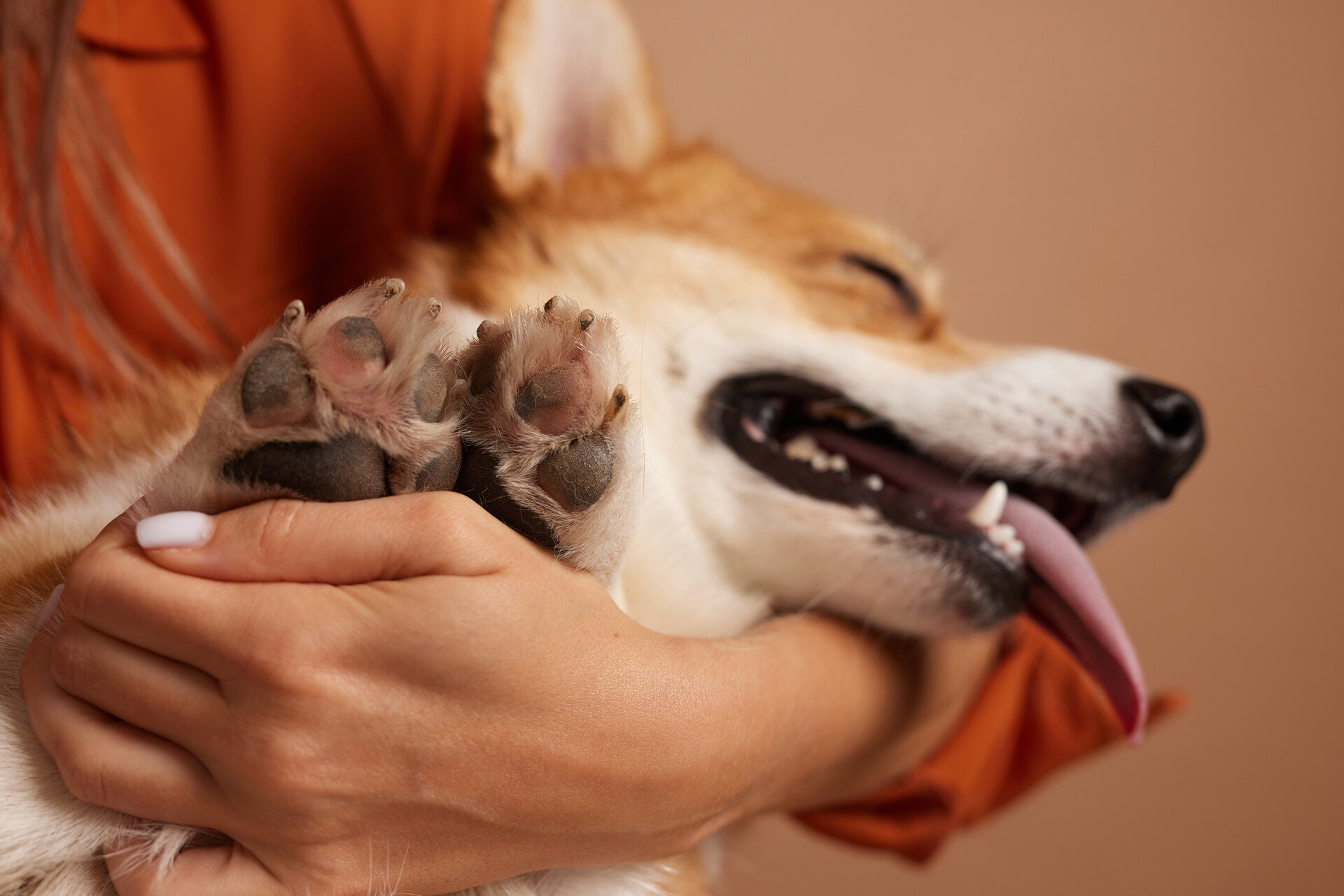
⚠️ Your dog might not be 100% comfortable with you touching their paws or feet right off the bat. In some cases, they might interpret this as dominant behavior and object. So vets recommend getting them used to you handling their feet from a young age.
Step 2: Figure out how far to trim dog nails
Be extra careful in this step since your dog’s nails are supplied with blood. An accidental clip in the wrong spot could lead to a lot of pain.
It’s easier to find the right range for dogs with clear or light colored nails, while it can be a bit trickier with dark nails. Luckily, a flashlight can help you better see the blood supply area.
Remember these 3 tips and you’ll be fine:
- The perfect cutting range ends right before the blood supply.
- Front paws are more likely to get overgrown nails.
- You should always cut parallel to the bottom.
Step 3: Trim your dog’s nails
Defined the cutting range? Good! Your dog is (ideally) in a relaxed position. You have your equipment ready. It’s time to start trimming your dogs nails!
- Trim by taking small steps at a time, and use rewards to keep your dog comfortable if needed.
- If there’s no blood at the end of the whole process and your dog behaves like nothing has happened, you’ve done everything right!
Once you’re done cutting, you can soften the skin around the nails with some paw balsam. It’s optional, but can be comforting for your pup. Trim the hair between the paws for perfect results.
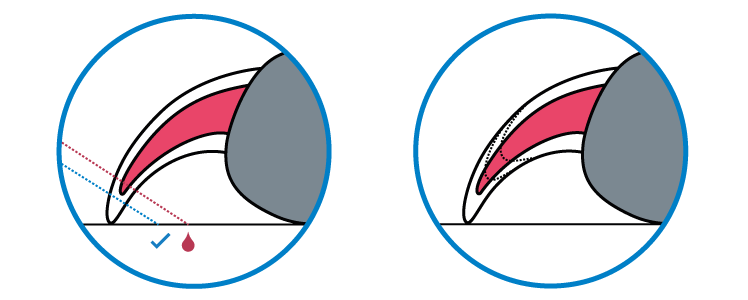
Step 4: Reward your good boy or girl
Don’t forget to reward your dog afterward! Only by doing so, your dog can associate the “unpleasant procedure” of nail trimming with something positive and this can reduce the fear.

How to trim overgrown dog nails
Are you taking care of a dog that already has extremely long nails? Check out the video below for tips on how to cut overgrown dog nails safely.
💡If you’re worried about your dog’s nail, paw, or health in general, always talk to your veterinarian. They can give you the best recommendations and treatments for your puppy.
How to stop a dog’s nail from bleeding
Even when you’re very cautious, it’s always possible that something goes wrong during this process. So here’s the golden rule: don’t panic if you see a little bit of blood on your dog’s nail.
- Instead, try to stop the blood flow with a clean cloth and prevent any dirt from getting in contact with the wound, so as to avoid infections.
- If the bleeding is minor, you could add some cornstarch to the area and apply gentle pressure to help reduce it.
- If the blood flow doesn’t stop after 30 minutes, contact your vet.
How often to trim dog nails?
In general, vets recommend trimming your dog’s nails every 1-2 months, though this can depend on factors like how fast your dog is growing and also how active they are.2 Dogs that are used to walking on soft ground (like parks or forests) can have a harder time controlling the length of their nails, compared to dogs that walk on hard ground (concrete or asphalt).
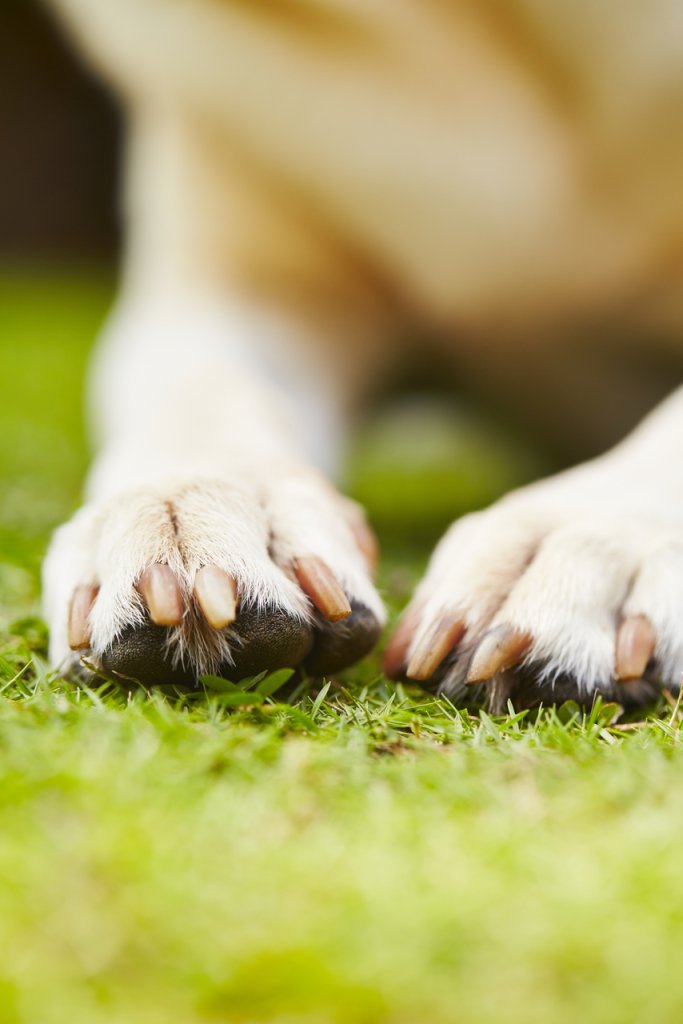
Besides, that’s not the only factor at play. Dog nail cutting requirements are also affected by:
- Genetic factors
- Your dog’s breed
- Feeding habits
- How active your dog is
💡In general, the more you trim your dog’s overgrown nails, the more the blood vessel will retreat back into the claw. Which makes frequent nail trimming essential for your dog’s health.
Wrapping up: How to trim your dog’s nails like a pro
You might be getting your dog for all their vet visits and daily walks – but their nails deserve a bit of attention too. Overgrown nails can cause them discomfort and pain over time. And left untrimmed, they can even affect your dog’s ability to walk or get around.
Ideally, it’s smart to get your dog used to having their feet and paws handled from a young age. Because if their nails are touching the floor or making a “clicking” sound as they walk – it’s time for a trim!
- Use a pair of dog nail clippers or a grinder to start the process. (Check with your vet for a medically approved option beforehand.)
- Get your dog relaxed in a familiar environment so they don’t spook as easily once you get trimming.
- Use a flashlight to determine the right cutting range in case your dog has dark nails.
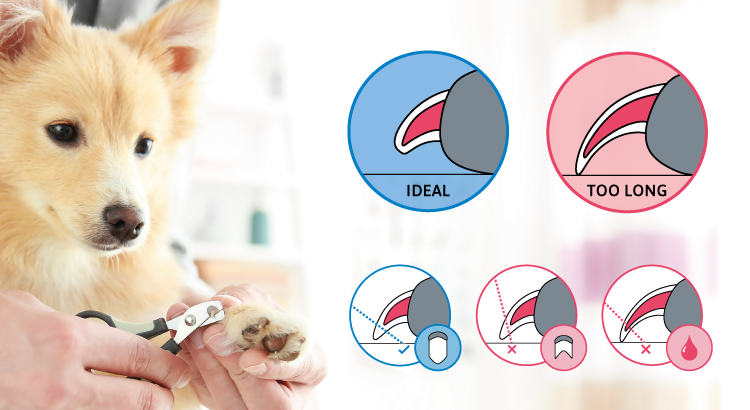
- Always trim parallel to the bottom. Reward your dog with plenty of hugs, praise, and treats throughout the process to keep them calm.
- If you notice any bleeding, stay calm and contain it with a clean cloth. This will help prevent infections. If the bleeding persists, get in touch with your vet immediately.
How often you’ll need to trim your dog’s nails can depend on factors like their activity level, breed, and whether they like to spend more time outdoors or indoors.
💡Besides, always consult with your vet in case you find yourself unsure how to proceed.
They’ll be best able to advise you what steps to take and how to go about the process best.
Want to see a dog nail trimming session at home in action? Here’s a quick video to get you started:
And if you’ve liked this post, share it with a friend or a loved one – and let’s help build a safer, kinder world for our furry friends together.
Your furry friend’s health and wellbeing means as much as to us as it does to you. So we’ve made it a priority to only share medically-relevant content on our blog.
This post was checked, double-checked, and medically verified by Georgia-based vet, Dr. Dwight Alleyne.
Dr. Dwight Alleyne, DVM
Dwight Alleyne was born and raised in Long Island, New York where his love of animals began. His career for animals began working for a well-known no-kill animal shelter on Long Island.

He worked his way up the career ladder working as a kennel technician, veterinary assistant, and then becoming a licensed veterinary technician at the shelter.
His passion for veterinary medicine led to him applying to and being accepted at Cornell University Veterinary where he graduated from in 2006. After completing a small animal rotating internship at Purdue University, he eventually made his way to Georgia where he has been practicing ever since.
Dr. Alleyne has practiced at several small animal clinics throughout Georgia. He has a keen interest in soft tissue surgery and has extensive experience in performing ultrasounds including echocardiograms.
When he is not practicing medicine, Dr. Alleyne enjoys writing and editing pet health articles and providing pet advice through telehealth.
Dr. Alleyne also has his own blog called “The Animal Doctor Blog.” Check it out on: www.anmldrblog.com.
